Wooden lathe follow-up
In this video, I answer some of the more frequently asked questions and comments I get on the lathe videos. Most of the questions that people asked are already covered by the articles on my website, or the videos themselves. But here is a summary of the questions I covered in the video:
Why did I build the lathe?
I used to often get the comment "Why don't you build a lathe?". Since building it, I get the occasional comment "Why did you build a lathe?". As explained in my first lathe video, I built it because I wanted to experiment with using wooden bearings for a machine, and also, having gotten so many comments about building a lathe, I figured there was interest in the topic.Why did I use maple for the bearings?
Because I wanted to see if maple would be good enough. There are better woods for bearings, such as lignum vitae. Or I could have made holders for bronze sleeve bearings or ball bearings. But I wanted to see if wood would hold up. So far so good, though I had to be careful to keep the wood well oiled until it was saturated with oil.How long do wooden bearings last?
So far, I haven't seen any signs of wear. If they eventually do wear, I can replace them easily and cheaply.How powerful is the motor, what type of motor?
The motor I used is a 1750 RPM 1/3 hp induction motor. The motor has a very weak starting torque and is barely powerful enough when doing bowl turning. I can stall the lathe if I want to. But a weak motor is also a useful safety feature.Why is there no belt guard?
The pulley is right next to a spinning workpiece that you hold chisels up to. The workpiece is much more dangerous than the belt. If you don't have the sense not to get your fingers into the belt, you really shouldn't be using a lathe, let alone build one.Heavier would be better
Ideally, this lathe would be made of something really heavy, like cast iron. That would help cut down on vibrations. But I like having a lathe that is easy to put away when I'm not using it, and this one is very good at that. The issue of lightness and vibrations can be mitigated by clamping it down on a heavy workbench.No power switch
I didn't install a power switch on this lathe. The motor is a separate unit, and so far I have been using a cord with a plug and socket at the end, which allows me to switch things on remotely. Very handy.Though this time I used it, I just plugged it into the switched socket on the back of my bandsaw and unplugged the bandsaw's motor. So I switch it on by switching the bandsaw's power switch.
Plugging it into a power bar with a switch is another option.
Lathe chuck threaded rod
A suggesting that has come up many times is that instead of four pieces of threaded rod, I should have one piece of threaded rod that goes all the way through, and through the metal shaft. This would be an improvement over what I made, though the other two pieces of threaded rod would still be attached the same way. It would be more difficult to make it, which is why I haven't done it this way, but you would be welcome to do it this way.Lathe chuck lock nuts
A very good suggestion that keeps coming up is to use "lock nuts", the type with a built in nylon washer, that makes the nuts have a lot of friction on the threaded rods. This would prevent them from coming loose. I changed the plans to suggest using lock nuts, though I haven't bothered to change the nuts on mine. If one of the jaws were to start coming loose, the stock would probably also become loose, so before the jaw flies off, I'd notice the stock going all wobbly and stop to investigate.How dangerous is the 4-jaw chuck
When run at normal turning speeds for bowls, a simple rubber band around the 4-jaw chuck will prevent the jaws from flying off if the nuts were to come off. Speeding it up to 1500 RPM (too fast for bowl turning), it takes two rubber bands to keep the jaws from flying off.I worked out how fast the jaws on the 4-jaw chuck are moving, and they aren't moving any faster than someone throwing something across the room. So getting hit by one of those jaws flying off wouldn't cause serious injury. I rounded the edges of the jaws so that if I did get hit by one, it wouldn't hurt as much.
Why not make a Longworth chuck?
It's been suggested I should make a longworth chuck for my lathe. This sort of chuck is used to hold the rim of a bowl when finishing up turning the bottom. It's certainly possible to make this style of chuck out of wood. But I'm not into bowl turning very much, and I think I would prefer to just screw some blocks of wood to a large face plate to hold the rim of a bowl. Maybe if I made a lot of bowls, it would be worthwhile, but I don't have a use for wooden bowls at this time.Why not mount the 4-jaw chuck to the faceplate, or the faceplate to the 4-jaw chuck?
It's often been suggested that I should make a faceplate that mounts to the 4-jaw chuck so I don't have to flip over the drive shaft to switch over. Or that I should make a 4-jaw chuck that bolts to the faceplate.I suppose bolting things to the faceplate is a reasonable idea, but I like having both faceplate and 4-jaw chuck directly on the shaft, so my preference is to just put those on either end of the shaft. Flipping the drive shaft over isn't that inconvenient.
Why not make a self-centering chuck?
I don't think wood is a suitable material for trying to make self centering chuck. It would be too weak and too inaccurate. Centering a 4-jaw chuck isn't that much work, and I can tweak it until the workpiece is exactly on center.What plywood did you use?
For the chucks, I used baltic birch plywood. It's great plywood for building jigs and machines, but more expensive than regular plywood. You can buy it at places like The Home Depot where the "handy panels" are. These are 2'x4' pieces of plywood. You can get a better price for this type of plywood at a hardwood store.Why did you ruin a perfectly good drill chuck?
I have gotten a lot of flack from machinists about how I made the machine taper for the drill chuck. It was an experiment, and it worked. It's not up to machinist standards, but it worked. The drill chuck is not ruined. I can still take it off, and if I had a drill press that it fit on, I could mount it on there.What CAD program did you use?
I used SketchUp. I make that pretty clear in many places on my website, but the question keeps coming up. I don't bother answering these questions. If you care enough to look for the answer, it's not hard to find.Where can I get the plans?
You can buy the plans here. Sorry, I do charge money for the plans. I'm not into chasing sponsors or promoting mattresses, razors or eBooks. I don't like excessive amounts of advertising, so I charge for the plans to earn some money from my work. But you don't have to buy the plans. You could just use my articles as an inspiration and work out your own set of dimensions for your lathe.
In conclusion...
Overall, this lathe has been quite a fun project, and a lathe in turn is fun for making little projects on.But a major downside with lathes is that you have to look for projects that can be made on a lathe. Most of my (non lathe) projects start with a problem, and I build something to solve that problem. But there aren't very many problems that can be solved using a lathe.
Many more frequently asked questions
See also:
Projects using the homemade lathe:
Back to the Lathe main index
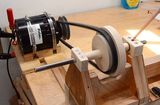 Building a lathe
Building a lathe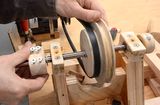 Lathe improvements
Lathe improvements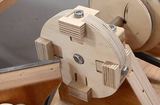 Homemade 4-jaw lathe chuck
Homemade 4-jaw lathe chuck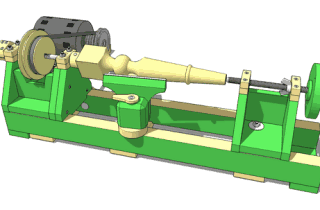 Buy plans for the lathe
Buy plans for the lathe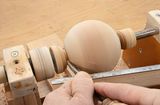 Ball (turning a sphere)
Ball (turning a sphere)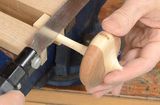 Spinning top
Spinning top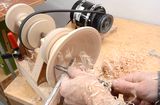 Bowl
Bowl Captive ring baby rattle
Captive ring baby rattle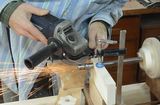 Grinding a machine taper with an angle grinder
Grinding a machine taper with an angle grinder